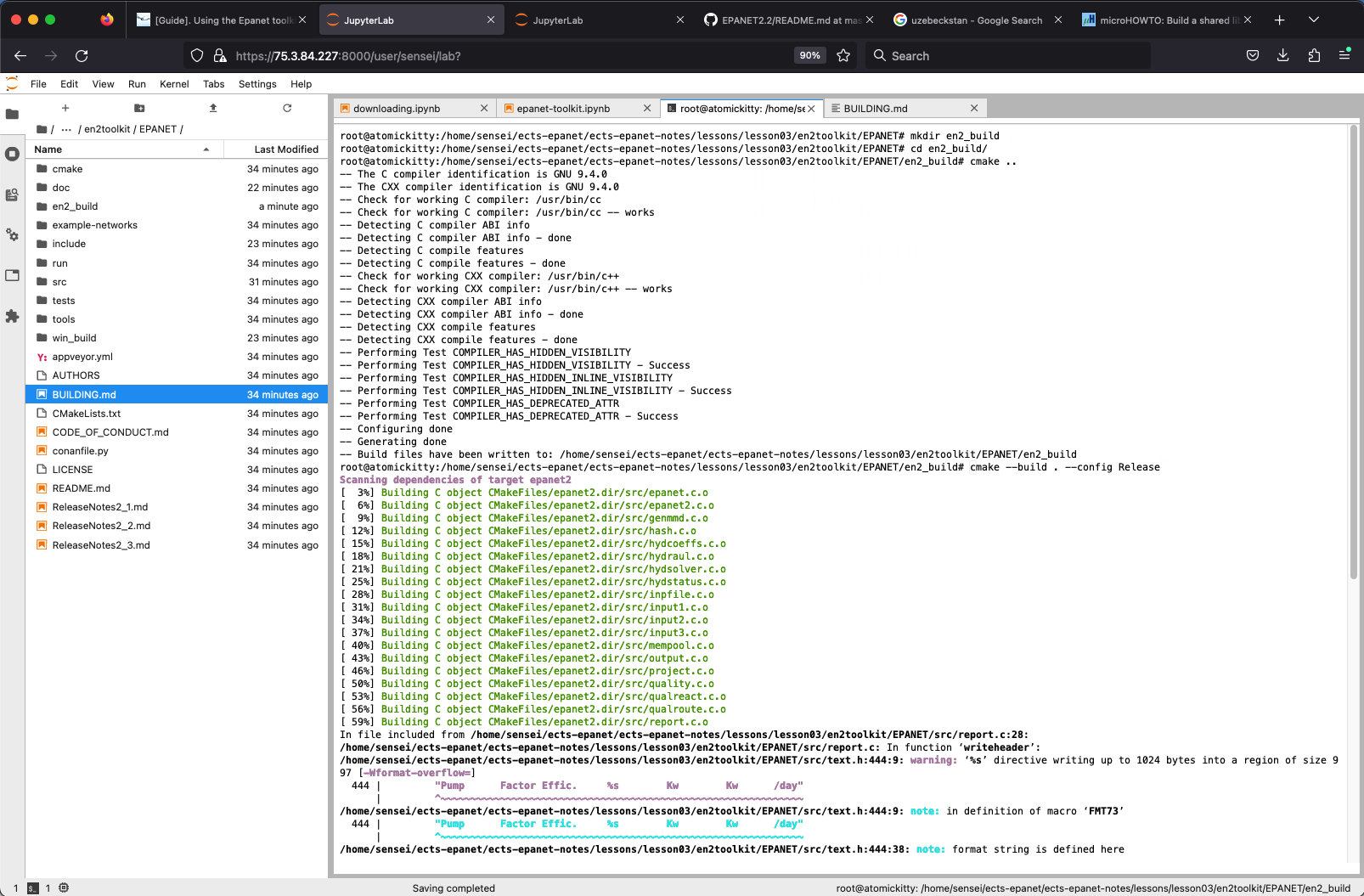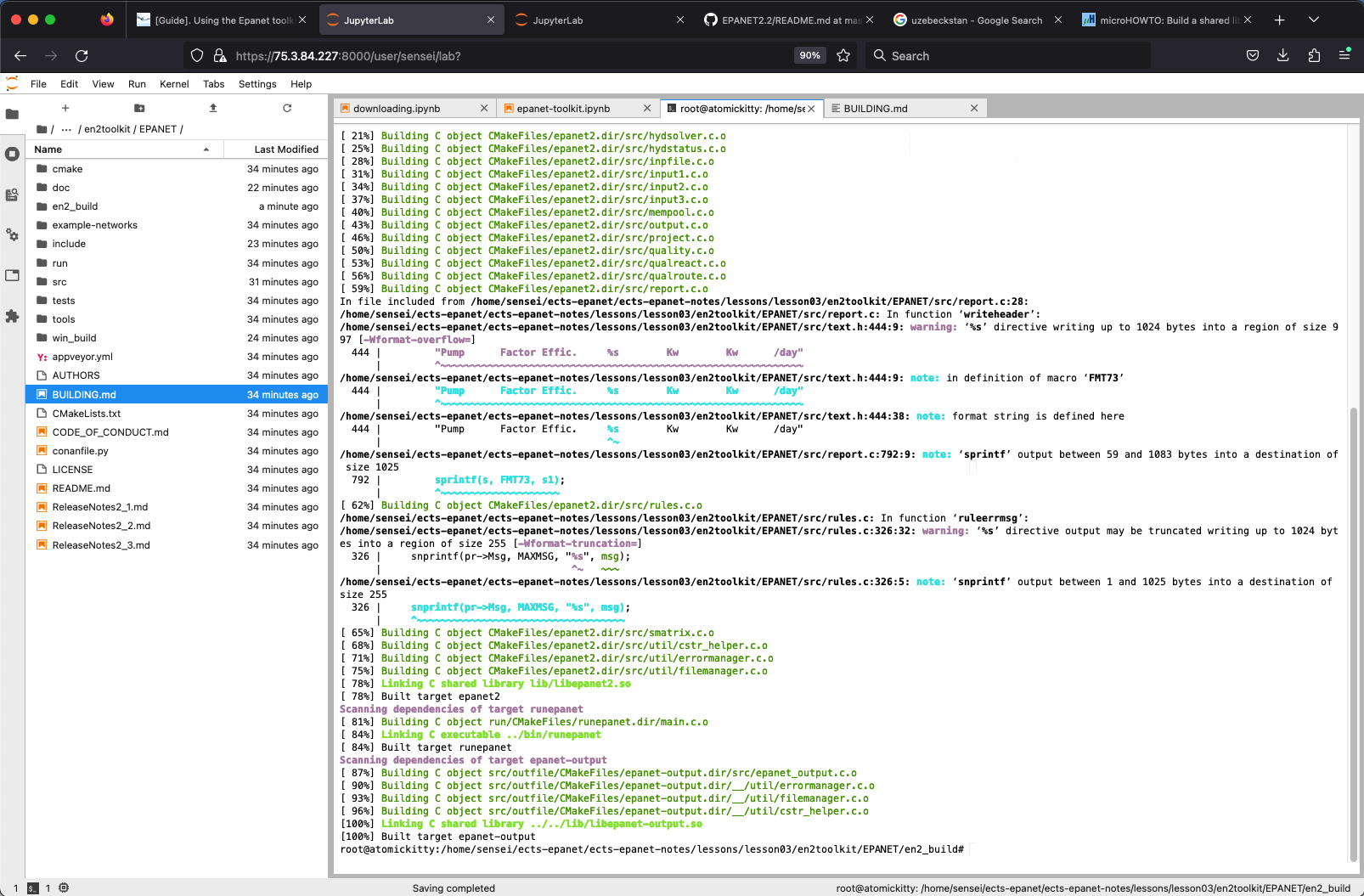3 EPANET Programmers Toolkit
Contents
3 EPANET Programmers Toolkit#
The EPANET Programmer’s Toolkit is a software applications programming interface (API) designed to facilitate the analysis and simulation of water distribution networks. Developed by the United States Environmental Protection Agency (EPA), EPANET is widely recognized as a comprehensive and reliable hydraulic and water quality modeling tool. The EPANET Programmer’s Toolkit offers engineers and researchers the ability to harness the full potential of EPANET’s capabilities, providing a platform for advanced water network analysis and optimization, directly accessing the computation engine without requiring the Graphical User Interface (GUI), or running the program in a batch mode with a prebuilt input file.
Overview#
The EPANET Programmer’s Toolkit provides essential functions that allow users to manipulate EPANET models and retrieve critical information for hydraulic and water quality analysis. With the toolkit, users can access network data such as pipe and node properties, demand patterns, and control settings. This information can be modified or updated programmatically, enabling engineers to conduct what-if scenarios, optimize system design, and assess the impact of various operational strategies on network performance.
One of the toolkit’s key features is its ability to perform hydraulic and water quality simulations. Users can dynamically simulate water flow and pressure behavior in the network, enabling accurate prediction of system performance under different operating conditions. Moreover, the toolkit allows for the analysis of water quality parameters, such as chlorine concentration and contaminant transport, aiding in the evaluation of water safety and compliance with regulatory standards.
The EPANET Programmer’s Toolkit empowers water industry professionals to tackle complex water network challenges with greater efficiency and accuracy. By leveraging its capabilities, engineers can optimize pipe sizing, evaluate system resilience, and assess the impact of infrastructure changes on network performance. The toolkit’s ability to perform advanced simulations and analysis aids in the identification of potential issues, facilitating proactive decision-making and improving overall water network management. Furthermore, the EPANET Programmer’s Toolkit plays a crucial role in supporting research and innovation in the field of water distribution system analysis, fostering the development of new methodologies and solutions to address emerging challenges in water management.
Note
link to EPANET toolkit description here :::
Purpose#
The primary purpose of the EPANET Programmer’s Toolkit is to enhance the functionality of EPANET and enable users to access its full potential in water distribution network analysis. The Toolkit serves as an interface that allows engineers and researchers to programmatically access and manipulate EPANET models, retrieve critical information, and perform hydraulic and water quality simulations without having to access the model through the Graphical User Interface (GUI). By providing essential modeling access functions, integration capabilities, and customization options, the toolkit enables analysts to conduct in-depth analysis, optimize system design, and evaluate the performance of water networks under various operational conditions.
The EPANET Programmer’s Toolkit supports integration with various programming languages, including C, C++, and Python, making it end-user adaptable to different software development environments. This flexibility allows engineers and researchers to leverage their preferred programming languages and frameworks, facilitating seamless integration with existing tools and workflows. Additionally, the toolkit’s extensive Application Programming Interface (API) documentation and code examples provide valuable resources for developers, enabling them to extend EPANET’s functionality and customize the software to meet specific project requirements.
Installing on a Raspberry Pi#
This section is specific to my development computer - the process is:
Download source files.
Build a shared object library.
Copy the library (or path to the library) into a working directory where you intend to run scripts.
Write and run your scripts to implement EPANET from python.
Download source files#
Easiest is to create a directory, navigate to that directory, then clone the GitHub repository.
# As regular user or root user
mkdir en2toolkit
cd en2toolkit
git clone https://github.com/OpenWaterAnalytics/EPANET.git #clone the remote into the directory
After the repository is cloned, step 1 above is complete
Copy the library to the working directory#
For my example herein, I copied the build into:
http://ects-epanet/ects-epanet-notes/lessons/lesson03/
I also copied two EPANET input files Net1.inp and Net1g.inp
The listing below shows the directory, you can see the shared object library at the end of the listing, as well as the two input files for subsequent examples. Also note the presence of a file named epamodule.py which is used below to access the toolkit.
! ls -la
total 1592
drwxrwxr-x 10 sensei sensei 4096 Aug 4 05:38 .
drwxrwxr-x 8 sensei sensei 4096 Aug 1 01:06 ..
drwxrwxr-x 2 sensei sensei 4096 Aug 4 05:38 .ipynb_checkpoints
-rw-r--r-- 1 root root 5104 Jul 29 03:50 EX3.inp
-rw-rw-r-- 1 sensei sensei 31504 Aug 4 05:05 ICTSummerSchool2023.ipynb.bak
-rw-rw-r-- 1 sensei sensei 3732 Aug 4 05:05 Junk.rpt
-rw-rw-r-- 1 sensei sensei 6304 Jun 12 19:45 Net1.inp
-rw-rw-r-- 1 sensei sensei 46587 Jun 12 19:45 Net1.out
-rw-rw-r-- 1 sensei sensei 42849 Aug 4 05:38 Net1.rpt
-rw-rw-r-- 1 sensei sensei 6305 Jun 12 19:45 Net1g.inp
-rw-rw-r-- 1 sensei sensei 46674 Aug 4 05:25 Net1g.rpt
drwxrwxr-x 2 sensei sensei 4096 Nov 28 06:40 __pycache__
-rw-rw-r-- 1 sensei sensei 387806 Jun 12 19:45 buildtools1of2.png
-rw-rw-r-- 1 sensei sensei 402767 Jun 12 19:45 buildtools2of2.png
-rw-rw-r-- 1 sensei sensei 169 Aug 4 05:05 enlkyr5b
-rw-rw-r-- 1 sensei sensei 69 Jul 28 14:27 ensYZnxU
-rw-rw-r-- 1 sensei sensei 69 Jul 28 14:27 enxPe9Sj
-rw-rw-r-- 1 sensei sensei 32610 Jul 28 14:27 epamodule.py
-rw-rw-r-- 1 sensei sensei 5227 Jun 8 16:49 epanet-rules.ipynb.bak
-rw-rw-r-- 1 sensei sensei 9010 Aug 4 05:38 epanet-rulesAPI.ipynb
-rw-rw-r-- 1 sensei sensei 38834 Aug 4 05:21 epanet-rulesCLI.ipynb
-rw-rw-r-- 1 sensei sensei 33946 Aug 4 05:21 epanet-rulesGUI.ipynb
-rw-rw-r-- 1 sensei sensei 779 Jul 29 06:07 epanet-sensors.ipynb
-rw-rw-r-- 1 sensei sensei 16736 Aug 4 05:21 epanet-toolkit.ipynb
drwxrwxr-x 3 sensei sensei 4096 Aug 4 05:38 ex1-cr
drwxrwxr-x 3 sensei sensei 4096 Nov 28 06:40 ex1-tk
drwxrwxr-x 3 sensei sensei 4096 Aug 4 05:25 ex2-tk
drwxrwxr-x 3 sensei sensei 4096 Aug 4 05:25 ex3-tk
drwxrwxr-x 3 sensei sensei 4096 Aug 4 05:25 ex4-tk
drwxrwxr-x 3 sensei sensei 4096 Aug 4 05:25 ex5-tk
-rw-rw-r-- 1 sensei sensei 15189 Jun 12 19:45 example2.inp
-rw-rw-r-- 1 sensei sensei 572 Jun 12 19:45 example2.rpt
-rwxrwxr-x 1 sensei sensei 400904 Jun 12 19:45 libepanet2.so
Write and run your scripts to implement EPANET from python.#
Below we demonstrate the last step, to write and run scripts that implement EPANET from our iPython kernel.
First import the epamodule.py package.
import epamodule as em # import the package
---------------------------------------------------------------------------
OSError Traceback (most recent call last)
/tmp/ipykernel_219845/1326067120.py in <module>
----> 1 import epamodule as em # import the package
~/ects-epanet/ects-epanet-notes/lessons/lesson03/epamodule.py in <module>
10 _plat= platform.system()
11 if _plat=='Linux':
---> 12 _lib = ctypes.CDLL("./libepanet2.so") # For My Raspberry Pi
13 ## _lib = ctypes.CDLL("./en2tools.so.1.5.0")
14 ## _lib = ctypes.CDLL("./epanet2toolkit.so")
/usr/lib/python3.8/ctypes/__init__.py in __init__(self, name, mode, handle, use_errno, use_last_error, winmode)
371
372 if handle is None:
--> 373 self._handle = _dlopen(self._name, mode)
374 else:
375 self._handle = handle
OSError: ./libepanet2.so: cannot open shared object file: No such file or directory
Then run an example
em.ENepanet("./ex1-tk/EX1tk.inp", "./ex1-tk/EX1yk-live.rpt") # runs a complete simulation. input file must exist and have contents.
! cat ./ex1-tk/EX1yk-live.rpt
Page 1 Thu Aug 3 09:44:33 2023
******************************************************************
* E P A N E T *
* Hydraulic and Water Quality *
* Analysis for Pipe Networks *
* Version 2.2 *
******************************************************************
Input Data File ................... ./ex1-tk/EX1tk.inp
Number of Junctions................ 1
Number of Reservoirs............... 1
Number of Tanks ................... 0
Number of Pipes ................... 1
Number of Pumps ................... 0
Number of Valves .................. 0
Headloss Formula .................. Darcy-Weisbach
Nodal Demand Model ................ DDA
Hydraulic Timestep ................ 1.00 hrs
Hydraulic Accuracy ................ 0.001000
Status Check Frequency ............ 2
Maximum Trials Checked ............ 10
Damping Limit Threshold ........... 0.000000
Maximum Trials .................... 40
Quality Analysis .................. None
Specific Gravity .................. 1.00
Relative Kinematic Viscosity ...... 1.00
Relative Chemical Diffusivity ..... 1.00
Demand Multiplier ................. 1.00
Total Duration .................... 0.00 hrs
Reporting Criteria:
All Nodes
All Links
Analysis begun Thu Aug 3 09:44:33 2023
Node Results:
----------------------------------------------
Demand Head Pressure
Node cfs ft psi
----------------------------------------------
2 295.00 26.93 11.67
R1 -295.00 100.00 0.00 Reservoir
Link Results:
----------------------------------------------
Flow Velocity Headloss
Link cfs fps /1000ft
----------------------------------------------
frenchy 295.00 15.02 7.31
Analysis ended Thu Aug 3 09:44:33 2023
Now same example but more granular control.
#Open the EPANET toolkit & hydraulics solver
em.ENopen("Net1g.inp", "Net1g.rpt")
em.ENopenH()
em.ENsolveH()
em.ENsaveH() # need to save to a binary file before write
em.ENcloseH()
em.ENopenQ()
em.ENsolveQ()
em.ENreport() # now write report
# Close hydraulics solver & toolkit */
em.ENclose()
References#
OpenWaterAnalytics(epanet-python) The GitHub source for the
epamodule.pyabove.https://github.com/OpenWaterAnalytics/epanet/ The GitHub source for the code and build instructions for the shared object library above.
EPANET (EPA website) Links to current EPA distributed EPANET programs and source files.
EPANET2.2 EPA GitHub source.
EPANETTOOLS1.0.0 (A pypi.org package) A package manager for EPANETTOOLS.
mycopy Link to modified copy of
epamodule.pyNet1.inp Link to modified copy of
Net1g.inp Link to modified copy of
Note
Most of these sites cross-share content, so whether using OWA or EPA official you are likely getting the same program; if its use is for some official capacity (like a water utility) use the EPA sites as your source.
Links#
Directory with epamodule.py and libepanet2.so (for a Ubuntu/Raspberry Pi) You probably have to build the
.soon your own machine - but you can at least examine the structure hereDirectory of my
en2on a raspberry pi. Again you probably have to do own builds - but you can examine structure.



